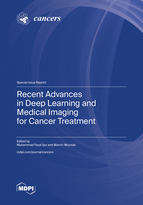Recent Advances in Deep Learning and Medical Imaging for Cancer Treatment
A special issue of Cancers (ISSN 2072-6694).
Deadline for manuscript submissions: closed (31 May 2023) | Viewed by 59206
Special Issue Editors
Interests: data science; machine learning; data structures and algorithms; systems engineering; neural networks; data mining; project management; tensor flow; predictive modelling; artificial intelligence; hadoop; apache spark; software development; empirical researchbig data
Special Issues, Collections and Topics in MDPI journals
Interests: computational intellgence; neural networks; image processing; expert systems
Special Issues, Collections and Topics in MDPI journals
Special Issue Information
Dear Colleagues,
Deep learning is a machine learning method that allows computational models composed of multiple processing layers to be fed with raw data and automatically learn various abstract data representations for detection and classification. New deep learning methods and applications are demanded with advances in medical imaging. Due to considerable variation and complexity, it is necessary to learn representations of clinical knowledge from big imaging data for a better understanding of health informatics. However, numerous challenges include diverse and inhomogeneous inputs, high dimensional features versus inadequate subjects, subtle key patterns hidden by sizeable individual variation, and sometimes an unknown mechanism underlying the disease. The challenges and opportunities in the field have inspired an increasing number of experts to devote their research to machine learning in medical imaging today.
The sudden increase in demand on the market for imaging science enhances the opportunities to develop new imaging techniques for diagnosis and therapy. New clinical indications using proteomic or genomic expression in oncology, cardiology, and neurology also offer a stimulus. This promotes the growth of procedure volume and sales of clinic imaging agents and the development of new radiopharmaceuticals. This Special Issue will bring together researchers from diverse fields and specializations, such as healthcare engineering, bioinformatics, medical doctors, computer engineering, computer science, information technology, and mathematics.
Potential topics include but are not limited to:
- Recent advances in bioimaging applications in preclinical drug discovery;
- Computer-aided detection and diagnosis;
- Image analysis of anatomical structures/functions and lesions;
- Computer-aided detection/diagnosis;
- Multimodality fusion for analysis, diagnosis, and intervention;
- Deep learning for medical applications;
- Automated medical diagnostics;
- Advances in imaging instrumentation development;
- Hybrid imaging modalities in disease management;
- Medical image reconstruction;
- Medical image retrieval;
- Molecular/pathologic/cellular image analysis;
- Dynamic, functional, and physiologic imaging.
Dr. Muhammad Fazal Ijaz
Prof. Dr. Marcin Woźniak
Guest Editors
Manuscript Submission Information
Manuscripts should be submitted online at www.mdpi.com by registering and logging in to this website. Once you are registered, click here to go to the submission form. Manuscripts can be submitted until the deadline. All submissions that pass pre-check are peer-reviewed. Accepted papers will be published continuously in the journal (as soon as accepted) and will be listed together on the special issue website. Research articles, review articles as well as short communications are invited. For planned papers, a title and short abstract (about 100 words) can be sent to the Editorial Office for announcement on this website.
Submitted manuscripts should not have been published previously, nor be under consideration for publication elsewhere (except conference proceedings papers). All manuscripts are thoroughly refereed through a single-blind peer-review process. A guide for authors and other relevant information for submission of manuscripts is available on the Instructions for Authors page. Cancers is an international peer-reviewed open access semimonthly journal published by MDPI.
Please visit the Instructions for Authors page before submitting a manuscript. The Article Processing Charge (APC) for publication in this open access journal is 2900 CHF (Swiss Francs). Submitted papers should be well formatted and use good English. Authors may use MDPI's English editing service prior to publication or during author revisions.
Keywords
- deep learning
- machine learning
- medical imaging
- bioimaging
- computer-aided diagnosis
- oncology







